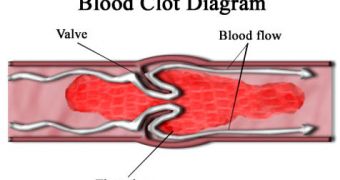In a new study, experts decided to use the evolutionary “lens” in order to understand the complex process of blood clotting. Gaining new insight into what happens at this time could help scientists develop new cures for bleeding disorders.
Whenever people cut themselves, even if the wound is minor, the body reacts by triggering a cascade of complex events and interactions, which ultimately lead to the formation of a blood clot, and to the wound being covered with healing material.
In the study, investigators at the Washington University School of Medicine in St. Louis (WUSM) tried to determine how key clotting proteins assemble at the site of an injury. In order to do that, they made use of evolutionary clues.
The von Willebrand Factor (VWF) tube-shaped protein is one of the most important actors in blood clotting. It travels through the human circulatory system, always searching for an injury. When such a site is found, the molecule unfurls its helical tube and begins catching plate.
When enough of these small structures accumulate, the blood clot form. Common inherited bleeding disorders such as von Willebrand Disease develop when the VWF protein is defective, and cannot perform some – or any – of its duties.
“The challenge for the cell is how to build this massive protein without clogging the machinery. The cell has solved this problem by making the assembly of von Willebrand Factor dependent on its location in the cell,” says J. Evan Sadler, MD, PhD.
The expert is referring to cells that produce VWF, which can be found in the inner lining of blood vessels. Sadler holds an appointment as a professor of medicine the WUSM. He is also the senior author of the new study, which appears in the July issue of the Journal of Biological Chemistry.
The group focused its attention on histidine, which are amino-acids that create the VWF molecule. These chemicals react to factors such as the pH of blood, and arrange themselves in various orders in the protein. Experts suspected that some of these arrangements may hinder the molecule's functions.
“By lining up the sequences, we found a relatively small number of histidines that are in the same place across species. It then becomes manageable to mutate them individually and see if that prevents von Willebrand Factor from assembling,” Sadler says.
“A positive charge at [two specific] positions is important for von Willebrand Factor to assemble properly so it can perform its biological function. Without VWF, you bleed,” the expert concludes, quoted by Science Blog.

 14 DAY TRIAL //
14 DAY TRIAL //